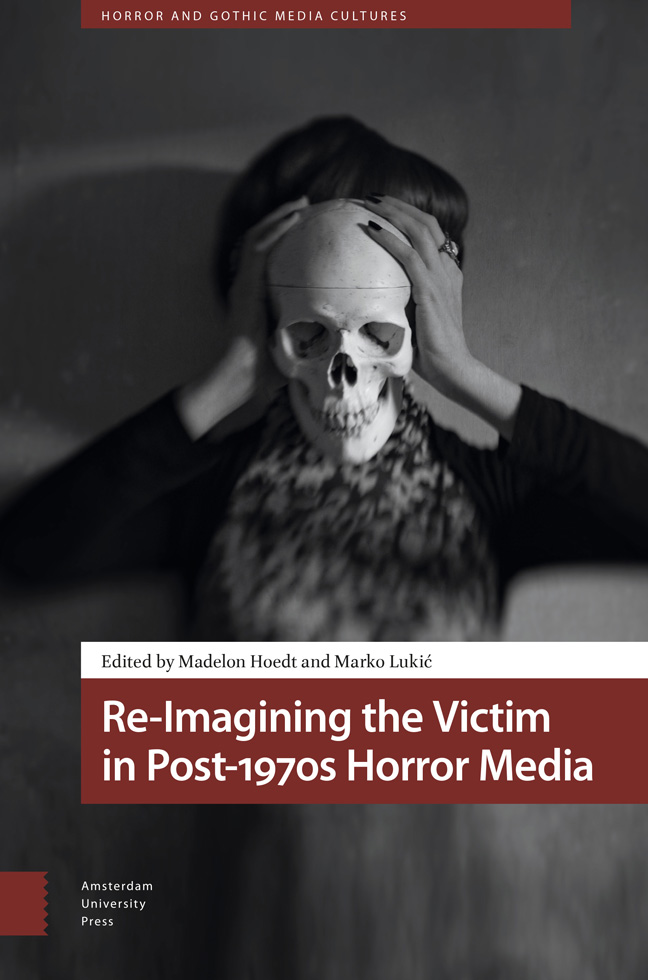Book contents
- Frontmatter
- Contents
- Introduction: Theorising the Victim
- 1 Opening the Gate: Reconfiguring the Child Victim in Stranger Things
- 2 Black Death: Black Victims in 1980s Teen Slashers
- 3 Beyond Binaries: The Position of the Transgender Victim in Horror Narratives
- 4 Through the Looking-Glass: The Gothic Victim in Jordan Peele’s Us
- 5 Postmortem Victimhood: Necrovalue in Phantasm and Dead and Buried
- 6 The Sad Killer: Perpetuating Spaces, Trauma and Violencewithin the Slasher Genre
- 7 “If this is the last thing you see… that means I died”: A Taxonomy of Camera-Operating Victims in Found Footage Horror Films
- 8 Victimhood and Rhetorical Dialectics within Clive Barker’s Faustian Fiction
- 9 Pain Index, Plain Suffering and Blood Measure: A Victimology of Driving Safety Films, 1955–1975
- 10 Biolithic Horror: Stone Victim/Victimisers in Resident Evil Village
- 11 The Potential Victim: Horror Role-Playing Games and the Cruelty of Things
- Bibliography
- Filmography
- Index
11 - The Potential Victim: Horror Role-Playing Games and the Cruelty of Things
Published online by Cambridge University Press: 26 March 2024
- Frontmatter
- Contents
- Introduction: Theorising the Victim
- 1 Opening the Gate: Reconfiguring the Child Victim in Stranger Things
- 2 Black Death: Black Victims in 1980s Teen Slashers
- 3 Beyond Binaries: The Position of the Transgender Victim in Horror Narratives
- 4 Through the Looking-Glass: The Gothic Victim in Jordan Peele’s Us
- 5 Postmortem Victimhood: Necrovalue in Phantasm and Dead and Buried
- 6 The Sad Killer: Perpetuating Spaces, Trauma and Violencewithin the Slasher Genre
- 7 “If this is the last thing you see… that means I died”: A Taxonomy of Camera-Operating Victims in Found Footage Horror Films
- 8 Victimhood and Rhetorical Dialectics within Clive Barker’s Faustian Fiction
- 9 Pain Index, Plain Suffering and Blood Measure: A Victimology of Driving Safety Films, 1955–1975
- 10 Biolithic Horror: Stone Victim/Victimisers in Resident Evil Village
- 11 The Potential Victim: Horror Role-Playing Games and the Cruelty of Things
- Bibliography
- Filmography
- Index
Summary
Abstract
This chapter explores ideas of victimhood and agency in horror roleplaying games through a lens of thing theory, drawing on the works of Mel Y. Chen, Bill Brown, Robin Bernstein and Jane Bennett to examine how the material objects that are used in such role-playing games are given the power to make victims of characters. In considering agential things against Christie’s “ideal victim,” the horror genre victim is reoriented in the changing relationship of objects and human subjects. This chapter argues that these objects, made into “things” by their power over the game’s narrative, reflect similar ideas of agency and subject-object relationships in day-to-day life.
Keywords: objects, thing theory, ideal victim, Call of Cthulhu, Dread, Ten Candles
We are all victims of physics.
– Scientist in anecdotal tweet by Laurel HamersThat we all are, or can be, victims of physics inscribes an agential form to a classical understanding of ideas such as gravity and force. It invokes a reversal of who and what can behave. As Mel Y. Chen writes in Animacies, there is the possibility of a linguistic “conceptual order of things, an animate hierarchy of possible acts” that they trouble significantly as they ponder the borders between the inanimate and the animate (3). In Chen’s early example of “the hikers that rocks crush,” they engage with the problem that “the hikers … play an object role” (2). The solution to the linguistic difficulty emerges when we animate the object, when the traditionally inanimate rock is given the free agency and subjecthood quality to crush the hikers. Upon this animation, the object becomes a thing, described by Robin Bernstein as when “the amateur’s knife should slip and cut a finger … that knife suddenly becomes a thing that has leapt up and asserted itself, a thing that demands to be reckoned with” (69), which centres her idea of “dances with things” as the kind of interplay between a human and the substantive things that they interact with daily. Bernstein borrows heavily from thing theorist Bill Brown’s assertion that “[t]he story of objects asserting themselves as things, then, is the story of a changed relation to the human subject” (4).
- Type
- Chapter
- Information
- Re-Imagining the Victim in Post-1970s Horror Media , pp. 213 - 230Publisher: Amsterdam University PressPrint publication year: 2024

